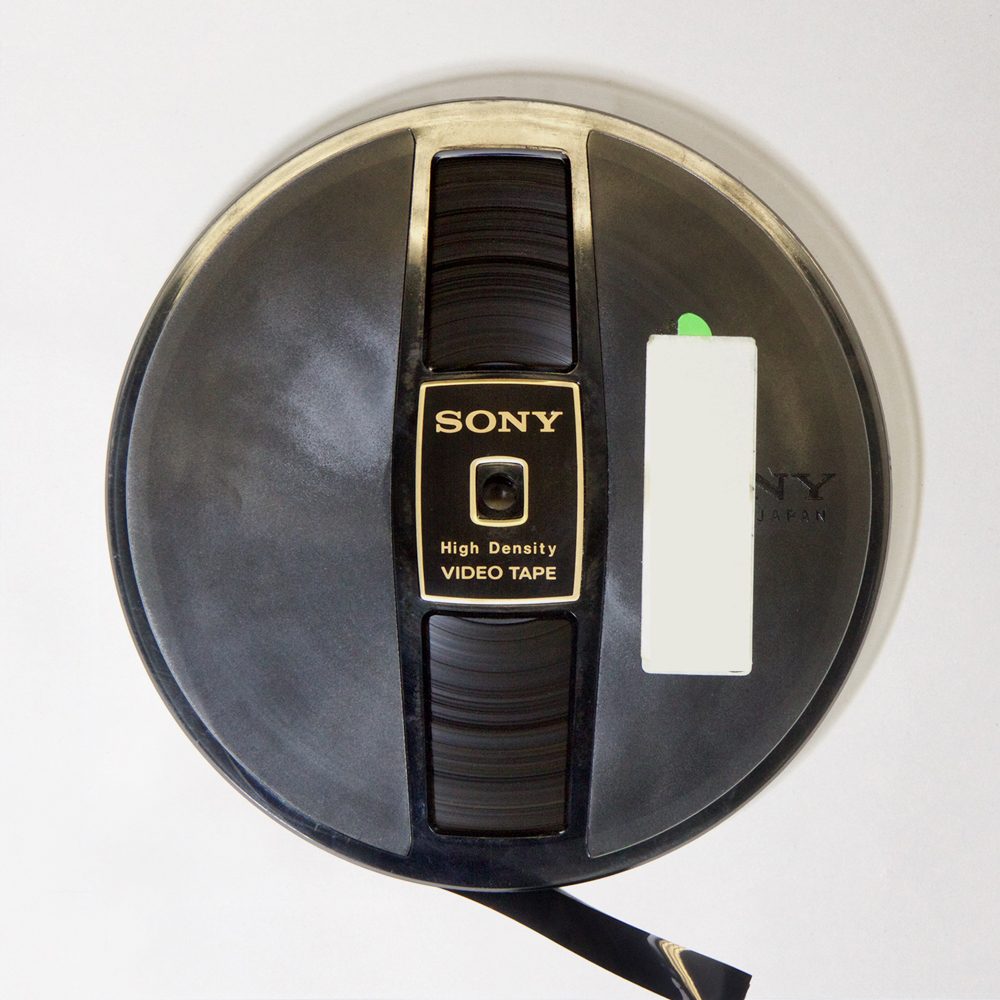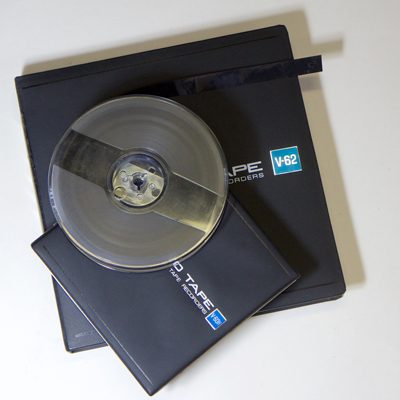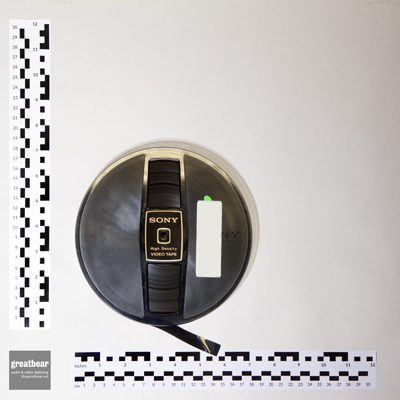introduction to ½ inch Sony CV-2000 / CV-2100 / EIAJ video transfer
Before Betamax and VHS, the main consumer video recording formats used half inch reel-to-reel tape with small suitcase-sized recorders. The relative affordability of the Sony Portapak (1967) camera plus VTR system, made it a popular tool for artists, experimenters, and social commentators.
The EIAJ format in type 1, black and white was the most common format and will account for the majority of recordings. Type 2, colour specification also exists, and we are able to transfer both types, having Sony CV machines, Shibaden and Hitachi EIAJ models and even a Panasonic time lapse machine.
We are able to transfer all standards of ½ inch (EIAJ & CV-2000 series) / Portapak open reel video from the UK (PAL) and US (NTSC).
The commonly-used Sony V30, V60, V30H, V60H or V62 tapes often suffer from sticky shed syndrome and require careful treatment before it’s safe to replay them. We can also digitise Panasonic EIAJ video cartridges that are usually labelled NV-xxxx
We offer a range of delivery formats for our video transfers. Following International Association of Sound and Audiovisual Archives TC-06 guidelines, we deliver FFV1 lossless files or 10-bit uncompressed video files in .mkv or .mov containers for archives. We can also produce Apple ProRes mezzanine files for ease of editing. We provide smaller viewing files as H.264 encoded .mp4 files or on DVD. We're happy to create any other digital video files, according to your needs.
We can provide the appropriately-sized USB delivery media for your files, or use media supplied by you, or deliver your files online. Files delivered on hard drive can be for any operating system MacOS, Windows or GNU/Linux and filesystems (HFS+, NTFS or EXT3).
½ inch reel-to-reel video recordings can vary both in duration and in the extent of physical tape degradation, so we always assess tapes before confirming the price of a transfer.
We offer free assessments - please contact us to discuss your project.
For an introduction to our assessment and treatment processes, please see our guide to "what happens to your video tape".
½ inch CV-2000 / CV-2100 / EIAJ video machines
- Sony CV-2100 ACE x 2 (PAL CV format)
- Sony AV-3620 CE x 3
- Sony AV-3670 CE
- Hitachi SV 610 (PAL EIAJ)
- Shibaden (Hitachi) SV620D (PAL Colour EIAJ)
- National NV-8030 (PAL EIAJ)
½ inch CV-2000 / CV-2100 / EIAJ video format variation
| ½" format | video standard | Sony High Density 'sticky shed' tapes treated | colour recordings supported | 405 lines supported |
|---|---|---|---|---|
| EIAJ | PAL | ✓ | ✓ | n/a |
| EIAJ Cartridge | PAL | ✓ | ✓ | n/a |
| EIAJ | NTSC | ✓ | ✗ | n/a |
| EIAJ Cartridge | NTSC | ✓ | ✗ | |
| CV2100 | PAL | n/a | n/a | ✓ |
| CV2000 | PAL | n/a | n/a | ✓ |
½ inch CV-2000 / CV-2100 / EIAJ tape risks & vulnerabilities
These ½ inch open reel video tapes can be particularly tricky to transfer well, due to the often deteriorated state the tapes can get into, the age and lack of availability of spares for the machines themselves and the inherent lack of tape interchangeability that this early non-broadcast format has.
In addition to the rarity of working machines and lack of spares, many of these ½ inch tapes have physically degraded over the years as they can be over 40 years old. Tapes which have binder problems, shedding oxide or tapes with mould growth must be treated before a successful transfer can be made. These types of problem are common with this format and Sony branded V60H, V62 and V30H Helical Scan tapes can sometimes be the worst. We have successfully restored and digitised a range of tapes, including part of a batch found at Bristol City Football Club.
While the quality is not high with this video format - which often has inherent visual issues such as dropouts, skew and head clogs due to shedding - the material recorded is sometimes of a very valuable nature and much less common than recordings made on later and often cheaper domestic equipment.
Half Inch Video Tape Brand / Type
- National / Panasonic
- NV-P50
- National / Panasonic Video Cartridge
- NV-P530H
- NV-P560H
- Sony High Density Video Tape
- V-30H
- V-60H
½ inch Sony CV-2000 / CV-2100 / EIAJ video history
Introduced by Sony (1965), the CV-2000 series were among the earliest video tape recorders. They utilised ½" wide video tape on open reels, with tape being threaded manually around the helical scan video head drum., They were the first fully-transistorised VTRs
The Portapak system arrived in 1967, with the Sony DV-2400 Video Rover: a two-piece battery-powered set, consisting of a black-and-white composite video camera and a separate record-only helical scan ½" portable video tape recorder. It required a Sony CV series VTR (such as the CV-2000) to play back the video.
CV-2000 series machines lacked the capacity for tracking adjustment - meaning tapes were not easily interchangeable between different machines.
In 1969 EIAJ (Electronic Industries Association of Japan) developed standardisation for ½" video tape, which became the norm for many manufacturers, including Sony with their AV series machines (which included tracking adjustability).
The EIAJ standard widened the adoptability of ½" video tape, and as machines became more affordable, the format became popular the early 1970s for non-broadcast use by businesses, schools, government agencies, hospitals, artists and even some home-consumers.
Portapak became a term for a variety of two-piece camera-plus-recorder systems manufactured by Sony, JVC and others, prior to the advent of camcorders.
½" video tape was superseded by easier-to-use cassette-based formats, such as Sony’s U-matic (1971).





